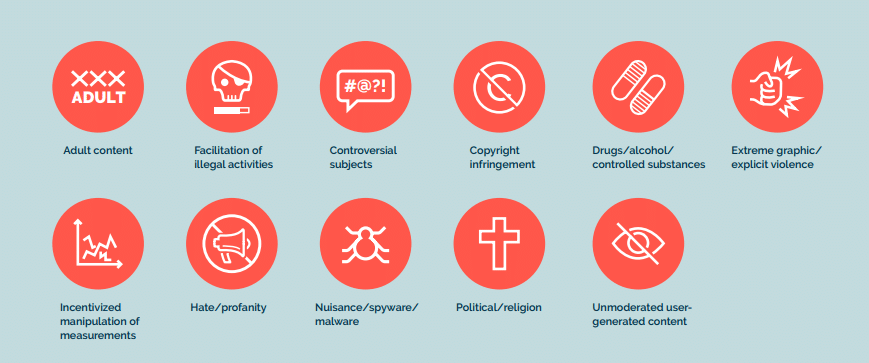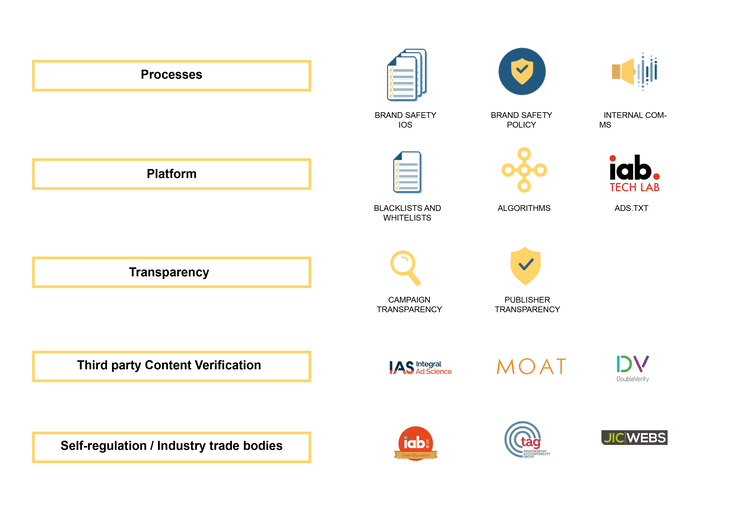Programmatic media is already a reality in marketing for many companies. To follow this strategy safely and efficiently, many resort to specific branding concepts, such as brand safety and brand suitability.
These are approaches that aim to protect companies in the digital context and ensure the best results.
Currently, not investing in these concepts can be fatal for many organizations. Thus, it is necessary to understand what they imply and how it is possible to effectively guarantee the protection of the brand’s name in the online world. In this way, you will be able to avoid the main consequences of having unwanted advertising on the web.
Read the article below. Here is everything we will discuss:
What is brand safety?
We understand brand safety as a set of protection strategies for the company in the digital world through the monitoring the environments where the brand name appears, and avoiding unwanted connections.
In other words, it is a set of approaches to prevent the organization from having ads on websites associated with crimes or practices that are frowned upon by society.
This is extremely relevant, after all, companies are increasingly prioritizing the construction of a profile, of an identity, almost similar to a human one, with values, mission and positions. The goal is to try to get closer to the customer, with an attitude that is pleasing to them.
In light of this, companies need to reinforce their concern with issues that matter to human beings—not necessarily associated with products or the commercial vocabulary.
Social guidelines, prejudice, intolerance, strategies to achieve a better world, among other issues are included. Generally, it is necessary to emphasize a positive message that is welcoming and far-reaching.
As Philip Kotler points out in his book Marketing 4.0, companies need to take a stronger moral and ethical stance. This involves the concerns we already mentioned.
When brands find themselves associated with environments that promote the opposite of what they try to convey, we have a brand compliance problem. The identity becomes fragmented and fails to be cohesive and transparent to customers. So, the restorative mentality of brand safety is necessary.
Assured reputation
The word safety, in this case, refers to the safety of the company and its reputation. It is to avoid being associated with crimes, adult content, fraud, hate speech and division, fake news, among other controversial factors.
These are sensitive issues that attract a negative image for the company, so they need to be avoided.

Brand safety emerges in a modern context, in which automation when buying ads is a standard. In this sense, softwares decide where to advertise, based on segmentation studies.
However, it is necessary to have protection measures to ensure that these systems do not place the brand in contexts that are not adequate.
The concept is associated with the idea of brand suitability, which concerns the environments where the company should actually be. In other words, places where potential customers go and that are associated with a positive image, valued by prospects.
With the ease of creating ads and spreading them across the internet, we can understand how brand safety is part of a global branding strategy as well.
What is its importance for safety?
Now, we will further discuss the importance of brand safety actions for protecting the business name and optimizing results.
Reputation
Reputation, as we have already mentioned, is a key aspect. We live in the era of virtual communities, where people often come together to talk about brands and products.
There are no limits for consumer expression in these spaces. Therefore, any gap that leads the company to be associated with a negative image can be explored and shared en masse.
If an organization is caught with ads in environments that do not represent what it promotes, for example, this can become fuel for conversations on social media and reach more people. So, a possible consequence is that a larger audience will be aware of your company, but will not have a good impression of it.
With brand safety strategies, the company will be able to control the spaces where the ads are served in order to avoid this negative result. It will have more precise management to improve brand compliance.
Competitiveness
Actions in brand safety help organizations to position themselves well. They can stay strong in the market to compete for the right customers. This becomes possible with the support of a strong and cohesive branding with clear values to be conveyed.
If your reputation is going well, competitiveness is too. Once the company’s image is positive in the eyes of the people, the business is able to establish authority and credibility to stand out.
Customer acquisition
The natural consequence of the improvements mentioned is an increase in the acquisition of the right customers. After all, if the company is able to monitor its ads and prevent programmatic media from directing efforts to unwanted channels, it can reach just the right consumers. You can speak directly to those in healthy environments.
Furthermore, with a good image on the market, it is easier to sell value to people. So, companies are able to win and convince prospects to follow and effectively close a deal.
Everything has to do with the brand positioning, with the way it is understood by people—which is optimized with the security and monitoring of ads.
Brand safety works in conjunction with marketing and sales actions. In this way, the entire sales team gains advantages if the customer already understands that the company is trusted by its identity.
If brand safety is not done well, on the other hand, the consumer objects to the company and the service based on image problems.
Money loss prevention
Another extremely important element is the quality of your investment. Brand safety actions help prevent spending from being directed to ads on sites that do not bring positive returns. That is, they help to prevent ads from being shown to the wrong people, consuming the amounts invested.
In contrast, these protection approaches help the company to truly optimize its advertising segmentation. In this way, campaigns will be effective in driving people through the funnel and achieving your main objective.
The loss of money involved in associating with sites that incite crimes and morally questionable issues occurs in different dimensions.
One is the lack of return on investment, as it is positioned on sites where people may not be interested in advertising. Another is the negative impact of the image harmed by this relationship.
What are the examples of the need for brand safety?
The term brand safety has existed and is relevant since the beginning of the 2010s. However, in 2016, with the American elections, the debate started to be more intense, since the term fake news started to be discussed more frequently.
From the importance of preventing the spread of fake news, companies began to realize the need to remove their ads from channels that contributed to misinformation. Then we started to think about ads on YouTube as well.
Channels that incited terrorism stopped receiving ads from companies. People mobilized to analyze the negative impact of this, in a way that managers started to notice. So, brand safety became practically a must.
During the Coronavirus pandemic, many sites invest in the dissemination of false information, manipulation and fraud involving the crisis. Businesses have already learned that they should not be associated with these spaces, so they look to monitor their ads closely.
How to protect your brand?

Let’s learn about some strategies to ensure brand protection in the digital world.
Machine learning algorithms
One of the most used solutions is the allocation of Machine Learning (ML) algorithms to help with filtering. They are able to conduct an in-depth analysis of the site in terms of content, images, videos, language, objective and more.
The great advantage of working with Artificial Intelligence (AI) is the ease of processing a lot of data at the same time and establishing an intelligent correlation between them.
ML uses natural language processing and Big Data analysis to understand pages and extract keywords. In addition, it is important to emphasize that the analysis is semantic, and not simply an understanding of the terms by themselves. The algorithms take into account the context of their application.
If, for example, the system is training with sites that are illegal, criminal, or that promote a bad value for the company’s reputation, it is able to learn and identify these patterns on other sites.
In addition, AI can go further: it is able to prevent ads from appearing on sites that are not necessarily illegal or have a bad image, but that do not represent a positive return for the company.
In this way, it is feasible to further control advertising in order to avoid spending money on strategies that don’t work.
Keyword and age filter
A simpler and less costly type of filtering than AI is the keyword and age filter. It consists, simply, in blocking certain expressions linked to something harmful to the company’s image.
In addition, it helps prevent ads from running on adult sites, for example.
As it is a more mechanical and simple method, there are some challenges and problems. One is the lack of semantic analysis, which considers the fact that two identical keywords can mean different intentions.
Because of that, this filter will be a little more broad and will cut more options, including some that are not necessarily negative.
Lists
Another widely adopted strategy is to split the options into a list of good sites and one of bad sites. In good alternatives, there are the domains that are actually visited by your target audience and that do not present any damage to your company’s image.
On the bad list are the domains associated with criminal or disreputable activities.
From a previous study, it is possible to fill the lists with dozens of URLs. Then, when buying ads, the media system is programmed to accept the options from the ideal list and reject the options from the other list. It works as a filter.
The interesting thing is that it requires constant learning in order to be able to identify more malicious sites. In other words, it is best to always add new names in order to guarantee effectiveness in brand safety.
Monitoring dashboard
Even with filters and AI support, the company must still maintain strict visual control of its ads. After all, the brand safety aspect is very important, as we have already seen, and requires global care. Therefore, having a dashboard to monitor actions and campaigns is also necessary.
This becomes a complement to automated actions: management maintains a broad view of the sites on which the brand name is appearing. With such clarity and transparency, it is easier to make quick decisions and reduce the negative impact of problems on this matter.
These dashboards can also serve as a tool to allow real time understanding of your metrics and results. In other words, the company manages to centralize the analysis of the campaign data and the information related to the brand safety in one solution to ensure success.
Sensitive classifiers
Another application is the one that grades the sites by sensitivity of the content covered. This approach has to do with age analysis, being specific to deal with this issue.
The manager can define which categories are to be considered sensitive and the system complies with these presets.
As we learned in this article, brand safety is a necessity for today’s world. Increasingly, organizations realize this and begin to move in that direction. So it is a matter of competitiveness to follow the flow and take precautions to take care of your company’s branding.
After all, a good reputation generates an adequate positioning, which generates sales. A bad reputation undermines the sustainability of the business.
Did you like the content? Don’t forget to subscribe to our newsletter to receive the latest articles about everything on digital marketing and content experiences!


![[ROCK NA] [EBOOK SEO] Complete Guide](https://rockcontent.com/wp-content/uploads/2024/06/banner_Search-Engine-Optimization.png)






